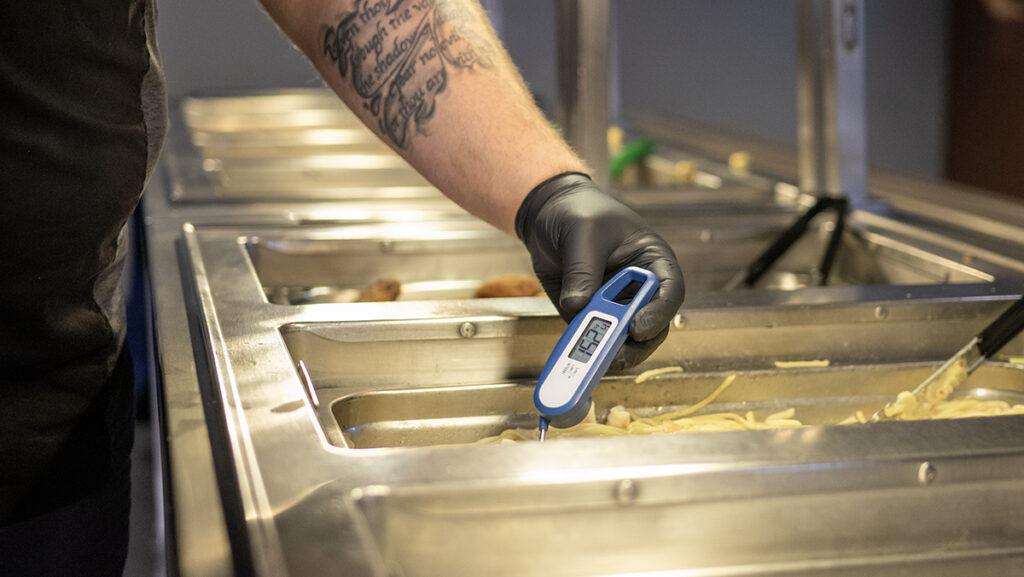Ithaca College first-year student Bianca Perlera started feeling nauseous in late March. When Perlera started vomiting and experiencing gastrointestinal symptoms, she recalled seeing photos of undercooked meat in the campus dining halls circulating on social media.
In November 2022, Barstool Ithaca posted an image of a piece of chicken from a campus dining hall that was cut open to reveal pink meat on the inside along with a video of a larva coming out of a burrito.
Perlera said that after seeing the post, she became wary of eating meat at campus dining halls. When her symptoms started, she assumed that she had contracted a foodborne illness from eating at the dining halls.
“Initially, I was like, ‘Oh, this is probably food poisoning,’” Perlera said. “I was assuming that I might have gotten a foodborne illness from probably something raw, like from the chickens.”
However, Perlera said she realized that she had a stomach virus when her roommate started experiencing similar symptoms, and both of their symptoms continued for almost a week.
Reginald Briggs, associate director and interim head of Dining Services, said students often misidentify gastrointestinal symptoms as food poisoning and attribute it to campus dining halls. Briggs said students may actually experience gastrointestinal distress because they have contracted viral gastroenteritis, which is commonly referred to as the stomach flu, or they have unrecognized food sensitivities.
“You literally have hundreds if not thousands of students that are away from home for the first time,” Briggs said. “Everybody’s … eating a completely different menu in a completely different environment. And in this setting where the menu changes every day, and you’re eating different stuff every day, [it] makes sense to me that some people would have an upset stomach every now and again.”
It can be challenging to determine the difference between food poisoning and viral gastroenteritis. There are several different viruses that can cause food poisoning, according to the Centers for Disease Control and Prevention. Depending on the virus that causes food poisoning, it can take anywhere from 30 minutes to two weeks for symptoms to set in. Symptoms for viral gastroenteritis typically start one to two days after exposure, according to Johns Hopkins Medicine. Both food poisoning and viral gastroenteritis cause nausea, vomiting and diarrhea, and symptoms of both conditions can last for a few days or up to a week.
Norovirus, a virus that causes vomiting and diarrhea, is contracted by eating contaminated food or water or being exposed to an infected person or contaminated surface. CDC data shows that norovirus cases increased nationally from January to March. Cases in the northeast increased from mid-February to early April. In February, NBC News reported that the rate of positive norovirus tests in 2023 surpassed the peak in 2022.
Jennifer Metzgar, director of Student Health Services, said via email that the Hammond Health Center has not seen any cases of foodborne illness linked to campus dining in Fall 2022 or Spring 2023. Additionally, the New York State Department of Health did not find any health violations in campus dining halls in its 2022 report.
“We do routinely ask about exposures and contacts,” Metzgar said via email. “We are seeing a few cases of viral gastrointestinal illness, but they have not been clustered or linked to any particular place or food.”
The CDC states that at least two people must become ill after eating a common food in order to declare a food poisoning outbreak.
Kevin Grant, executive chef manager, said Dining Services follow the temperature guidance from ServSafe, the NYSDH and Tompkins County Whole Health to ensure that food is safe to be consumed.
The danger zone — the temperature range in which food can cause illness — is between 40 and 140 degrees Fahrenheit, according to the U.S. Department of Agriculture Food Safety and Inspection Service. NYSDH mandates that hot food be at least 140 degrees and refrigerated food be below 45 degrees. Grant said Dining Services sets temperature requirements that are five degrees above the required hot food temperature or five degrees below the cold temperature to be extra cautious.
Grant said food temperature is examined at multiple stages of preparation. Dining Services tests the temperature of all of the food it receives from its vendors before the deliveries are brought into the facilities and does not accept products that do not meet the required temperatures. Once food is prepared, Grant said Dining Services’ staff use infrared thermometers and probes to test food temperature at least once per hour and then temperatures are recorded in a log. Staff members test at least half of the portions on trays of meat.
Sophomore Josh Scelfo said he believes he contracted foodborne illness from campus dining halls twice. He said he started feeling unwell in Fall 2021 after eating a chicken sandwich from the Campus Center Dining Hall.
“It didn’t taste the typical way that cooked chicken would taste,” Scelfo said. “I ate it and then a few hours went by and I got very sick. I don’t want to get into details, but it was multiple hours and I couldn’t go to my classes.”
Scelfo said he got sick again in Fall 2022 after eating chicken in the dining hall. Scelfo said he cannot be sure what caused his symptoms in both incidents. However, he said he assumes he had food poisoning because he saw the Barstool post and heard rumors of other students contracting food poisoning on social media.
Campus dining received health violations and complaints when it was managed by Sodexo. In Spring 2019, the college cut ties and began insourcing its food services. Briggs said that when the college introduced its own dining program, it hoped to improve food safety and relationships with the student body.
Scelfo said he believes Dining Services needs to improve communication about how food is prepared and monitored.
“I feel that it is extremely important for us as students to know what we’re eating every day,” Scelfo said.
Briggs said Dining Services is trying to implement new ways to seek student feedback, like placing feedback forms throughout the dining halls. Briggs met with the Student Governance Council in March to discuss the changes to the campus meal plans that will be launched in Fall 2023, as well as student representatives’ concerns about Dining Services.
Briggs said he asks students to discuss any concerns that they have about their food or food safety with Dining Services staff to allow them to address the problem before spreading rumors or posting about it on social media.
“What we want is the opportunity to correct issues in the moment,” Briggs said. “We do care a lot about this and we are doing things better than we ever have. But we need the student body to understand that and be part of that process of giving us regular up-to-date feedback so that we know where we stand. And if we need to do things differently or if it’s a bigger issue than we’re aware of, [then] we can fix it.”









